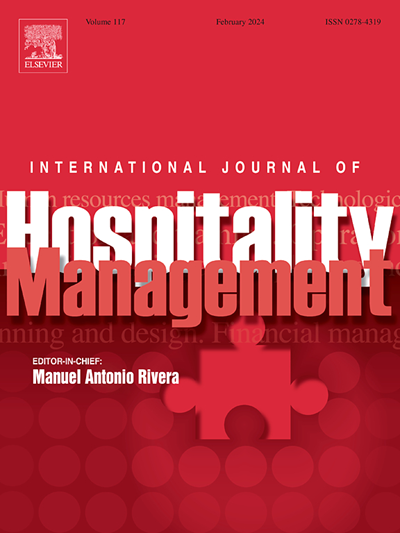From cafés to clinics: Consumer attitudes toward human-like and machine-like service robot failures
IF 9.9
1区 管理学
Q1 HOSPITALITY, LEISURE, SPORT & TOURISM
International Journal of Hospitality Management
Pub Date : 2025-05-30
DOI:10.1016/j.ijhm.2025.104319
引用次数: 0
Abstract
This study examines consumer evaluations of robotic service failures caused by human interference by integrating service context, robot appearance, and individual anthropomorphism tendencies into a unified model. Two between-subjects experiments were conducted. In Study 1 (N = 402), participants interacted with a healthcare or food-service bot that failed due to verbal interference. Healthcare service failure elicited significantly more negative attitudes and lower failure tolerance than food service failure, and failure tolerance fully mediated the relationship between context and attitudes. In Study 2 (N = 213), we employed a 2 × 2 design (healthcare vs. food services × human-like vs. machine-like robot) and measured perceived deservingness and trait anthropomorphism. Human-like robots were judged most harshly when failing in healthcare (vs. food) services, whereas machine-like robots received similar evaluations across contexts. Perceived deservingness of the robot mediated this interaction. Moreover, the moderated-mediation effect occurred only among individuals with low to medium anthropomorphism tendencies. By positioning failure tolerance and deservingness judgments as core mechanisms in human–robot interaction, our findings advance theoretical understanding of moral attributions in service failure. Practically, they highlight the importance of matching robot anthropomorphic cues to service criticality: less human-like designs in high-stakes environments, while more human-like appearances may be appropriate in lower-stakes settings.
从咖啡厅到诊所:消费者对类似人类和机器的服务机器人故障的态度
本研究将服务情境、机器人外观和个体拟人化倾向整合为一个统一的模型,考察消费者对人为干扰引起的机器人服务故障的评价。进行了两次受试者间实验。在研究1中(N = 402),参与者与由于言语干扰而失败的医疗保健或食品服务机器人进行互动。与餐饮服务失败相比,医疗服务失败引起的消极态度显著增加,失败容忍度显著降低,失败容忍度完全介导了情境与态度之间的关系。在研究2 (N = 213)中,我们采用了2 × 2设计(医疗保健与食品服务×类人与类机器机器人),并测量了感知应得性和特征拟人化。类人机器人在医疗服务(相对于食品服务)失败时受到的评价最严厉,而类机器机器人在各种情况下都得到了类似的评价。感知到的机器人应得性介导了这种相互作用。此外,有调节的中介效应只出现在低至中等拟人化倾向的个体中。通过将故障容忍度和应得性判断定位为人机交互的核心机制,我们的研究结果促进了对服务故障道德归因的理论理解。实际上,他们强调了将机器人拟人化提示与服务临界性相匹配的重要性:在高风险环境中,不那么像人类的设计,而在低风险环境中,更像人类的外观可能是合适的。
本文章由计算机程序翻译,如有差异,请以英文原文为准。
求助全文
约1分钟内获得全文
求助全文
来源期刊

International Journal of Hospitality Management
HOSPITALITY, LEISURE, SPORT & TOURISM-
CiteScore
21.20
自引率
9.40%
发文量
218
审稿时长
85 days
期刊介绍:
The International Journal of Hospitality Management serves as a platform for discussing significant trends and advancements in various disciplines related to the hospitality industry. The publication covers a wide range of topics, including human resources management, consumer behavior and marketing, business forecasting and applied economics, operational management, strategic management, financial management, planning and design, information technology and e-commerce, training and development, technological developments, and national and international legislation.
In addition to covering these topics, the journal features research papers, state-of-the-art reviews, and analyses of business practices within the hospitality industry. It aims to provide readers with valuable insights and knowledge in order to advance research and improve practices in the field.
The journal is also indexed and abstracted in various databases, including the Journal of Travel Research, PIRA, Academic Journal Guide, Documentation Touristique, Leisure, Recreation and Tourism Abstracts, Lodging and Restaurant Index, Scopus, CIRET, and the Social Sciences Citation Index. This ensures that the journal's content is widely accessible and discoverable by researchers and practitioners in the hospitality field.
 求助内容:
求助内容: 应助结果提醒方式:
应助结果提醒方式:


